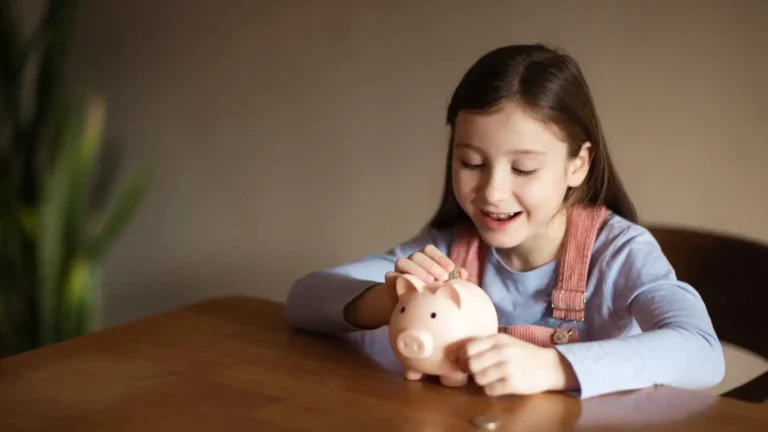Table of Contents
Grocery shopping is one of the most practical ways to involve kids in financial decisions. But it is often an overlooked opportunity for teaching kids valuable financial lessons.
Every trip to the store can turn into a mini classroom. It offers real-life experiences in budgeting, prioritizing, and comparison shopping. It also helps make smart decisions. Children can learn how everyday choices impact spending. This progression ranges from choosing between brands to understanding the distinction between needs and wants.
By connecting these lessons to real-world examples like Beem’s Everdraft™. It helps adults manage spending flexibility, and parents can show kids that smart shopping isn’t just about saving money. However, it’s about making thoughtful, informed financial decisions that foster lifelong money management skills.
Why Grocery Shopping Is the Perfect Opportunity for Financial Lessons
Everyday Relevance:
Grocery shopping is a familiar and regular activity. This is something kids can easily relate to. It makes it an ideal setting for real-world financial learning.
Hands-On Learning:
Instead of abstract lessons, kids can actively participate in hands-on learning. It can be achieved through touching products and comparing prices. This will enable real-time purchase decisions.
Visible Impact:
The results of smart choices (like saving money) or overspending are immediate and tangible, helping children understand cause and effect.
Foundation for Long-Term Habits:
Lessons learned in the grocery aisle make a huge impact. It can shape how kids approach bigger financial decisions later in life. This applies whether you are buying clothes, electronics, or managing your savings.
Step 1 — Teaching Budgeting and Setting Limits
Set a Budget Together:
Before you head into the store, you must give your child a fixed amount of money. You can also pretend to have money for younger kids. It will create a sense of ownership and responsibility.
Discuss the Budget:
Explain how much can be spent in total and how it’s divided across categories. This includes essentials, snacks, and treats. This helps kids understand how money is allocated.
Track the Total:
You must involve your child in adding up prices as you shop. This hands-on exercise teaches them to stay within limits. You can also make trade-offs and track expenses in real-time.
Practical Example:
Just like adults may use Beem’s Everdraft™ to manage short-term funds responsibly, kids learn how to prioritize spending. They must try to stick to a budget without overshooting.
Read related blog: What Is the Best Age to Teach Kids About Saving and Budgeting?
Step 2 — Needs vs. Wants: Making Smart Decisions
Define Needs vs Wants:
You can start by explaining the difference between them. This is between essential items and non-essential items.
Ask Thought-Provoking Questions:
You must encourage them to think critically with questions.
Real-Life Choices:
You must allow your child to make their own decisions.
The Long-Term Lesson:
This simple exercise helps children learn to prioritize their needs over their wants. This is a skill that mirrors how adults manage limited funds and make trade-offs. It is often with tools like Beem’s Everdraft™.
Step 3 — Price Comparison and Identifying the Best Deals
Explain Unit Prices:
Teach kids to look beyond the label price and compare the price per unit (like price per ounce or per piece). This helps them understand real value.
Show the Power of Generic Brands:
Compare store brands with name brands. Ask, “What’s the difference?” and “Is it worth paying more?” to help them make thoughtful choices.
Use Real Numbers:
Let them calculate how buying larger quantities or multipacks can save money over time.
Smart Spending:
Just like adults use Beem’s Everdraft™ to stretch their budget wisely, price comparison teaches kids how to get the best value and make cost-effective decisions.
Read related blog: Teach Teens Money Skills with Beem Pass
Step 4 — Encourage Smart Shopping Strategies
Meal Planning:
Teach kids how planning meals helps avoid impulse buys. It will also reduce food waste. This will also help save money in the long run.
Make a List and Stick to It:
You must show them how creating a shopping list helps. It must be based on actual needs, and keep spending focused. It will prevent unnecessary purchases.
Impulse Buying:
You must use real-time examples in the store. You can ask questions like, “Do we really need this?”
or
“Can we wait until next week?”. This will help them think critically before adding extras.
Real-World Analogy:
Just as Beem’s Everdraft™ helps adults manage short-term cash flow responsibly, planning and sticking to a list teaches kids how to stay in control of their spending. It will make smarter shopping choices.
Step 5 — Teach the Importance of Sales and Discounts
Explain Sales and Coupons:
You can introduce kids to the concept of sales, discounts, and coupons. This will explain how they can help save money when used wisely.
Assess Value vs Discount:
You can remind them, “Just because something is on sale doesn’t mean we need it.
Are we really saving money, or just spending it differently?”
Show How Bulk Buying Works:
Demonstrate how buying essentials in bulk can sometimes offer better value, helping stretch the budget further.
Relatable Example:
Just like Beem’s Everdraft™ helps adults cover short-term expenses smartly, you can use discounts strategically. It will help maximize spending power. Kids learn that smart shopping isn’t about grabbing every deal. But it’s about buying what’s needed at the best value.
Read related blog: Parent Spending Strategy for Teens: Boundaries That Teach
Step 6 — Managing Special Treats and “Extras”
Treats and Rewards:
You should give your child a small budget for non-essential items. It can be for things like candy, toys, or small games. This gives them freedom to choose within limits.
Ask Questions:
You must encourage them to think with prompts. It can be questions like,
“What would you like to buy with your $5 today?”
or
“Is there something you’d rather save for?”
The Lesson:
This teaches kids that it’s okay to enjoy little treats. However, it must also include saving up for bigger goals, as this often brings greater satisfaction.
Everdraft™ Analogy:
Just like adults use Beem’s Everdraft™ to handle unexpected expenses responsibly, kids learn to manage their treat budget wisely. You can help them plan future indulgences without overspending.
Step 7 — Teaching the Value of Sustainability
Reduce, Reuse, Recycle:
Kids must learn the importance of buying only what’s needed. You can reuse what they can.
Discuss the Long-Term Impact:
You must show how investing works. They must opt for durable, high-quality items, as this can save money over time. You can compare to cheaper, disposable alternatives.
Environmental Awareness:
You must help them understand the concept of mindful shopping. It not only saves money but also supports a healthier planet.
Everdraft™ Parallel:
Just like Beem’s Everdraft™ encourages responsible use of resources, kids learn that smart shopping means making thoughtful choices—benefiting both their budget and the environment.
Step 8 — Let Kids Experience Financial Responsibility
Give Them Their Own “Shopping Budget”:
Let kids manage a set amount of money for a specific purchase. This gives them real control and decision-making power.
Review Together:
After shopping, you can talk about what went well. This way, you know where they could make smarter choices next time.
Reflect on Decisions:
You must ask questions like, “How did you feel choosing to skip the toy to save for something bigger?”. It will help them think through their spending.
Build Confidence:
This experience strengthens their financial confidence. It teaches the value of long-term rewards over short-term spending.
Real-World Parallel:
Kids learn to plan purchases thoughtfully and make more informed financial decisions. It is just like adults use Beem’s Everdraft™ responsibly to manage short-term needs.
Read related blog: How to Introduce Kids to Bank Accounts and Online Money Safely
Step 9 — Encourage Reflection After Shopping
Reflect on Purchases:
Once the shopping is done, you must sit with your kids. You can discuss what was bought. Ask simple questions like:
- “What did we spend the most money on?”
- “Was there anything we didn’t really need?”
Learn from Mistakes:
If they went over budget or picked unnecessary items, you can discuss why it happened. You can ask how to make better choices next time.
Build Self-Awareness:
This reflection helps kids understand their own spending habits. It is just like adults reviewing their financial choices when using tools. You can use tools like Beem’s Everdraft™ to stay in control and on track.
Step 10 — Reinforce Lessons by Tracking and Planning Together
Track Spending:
Encourage kids to jot down what they spend during grocery trips. You can use a simple notebook or an easy app.
Discuss Results:
After a few trips, review together—Did they stick to the budget? What worked well? What could be better next time?
Make It a Family Habit:
You can turn budgeting and reflection into a weekly or monthly family routine. It helps build consistency and awareness.
Real-World Habit:
Just like adults use Beem’s Everdraft™ to manage short-term expenses within a larger financial plan, this step helps kids see shopping as part of a bigger money management strategy.
Read related blog: Teaching Teens About Paychecks, Taxes, and Real Job Income
How Beem’s Everdraft™ Can Help Model Smart Shopping for Kids
Beem’s Everdraft™ gives adults a smart way to manage short-term expenses without interest, while still encouraging mindful budgeting. Parents can use this as a simple example for kids:
- “Just like we use Everdraft™ for unexpected costs, we plan before spending.”
- “Smart pocket money use means balancing needs and wants—just like our family budget.”
This mirrors what kids learn during shopping trips: smart spending is about planning, prioritizing, and staying in control.
Conclusion
Grocery shopping isn’t just another household task. However, it’s a powerful and hands-on opportunity. It can help you teach kids valuable lessons. It is about budgeting and prioritizing daily financial decisions. This will help them make smart financial choices.
Parents can help them build lifelong money skills. This is done by involving children in real-world shopping decisions. This ranges from distinguishing needs and wants to sticking to a budget.
Kids can learn about smart spending. This can be done wth the right approach and simple financial tools. It requires help from platforms like Beem’s Everdraft™ as a practical example. Download the app now!
FAQs on Financial Lessons Parents Can Teach Kids During Grocery Shopping
How young should I start involving my kids in grocery shopping?
You can start as early as 5 or 6 years old. This is done by involving them in simple tasks. It can include tasks such as selecting items, comparing prices, or managing their pocket money.
Should I let my child make all the shopping decisions?
You must start by giving them small and manageable decisions. This will gradually increase their responsibilities. This shows understanding and accountability.
How can I make grocery shopping more educational for my kids?
You can ask questions like “Is this a need or a want?” or “What will be a better value?”. It will encourage critical thinking.
How does Beem’s Everdraft™ help model responsible spending?
Everdraft™ teaches responsible, interest-free borrowing. It is just like how you want your kids to understand the difference between mindful spending and impulsive buying.
Should I teach my kids to shop for the lowest price or the best value?
You must teach them the importance of value. They must understand that cheaper isn’t always better. If the quality or long-term utility isn’t there, it’s better to avoid such things.















































